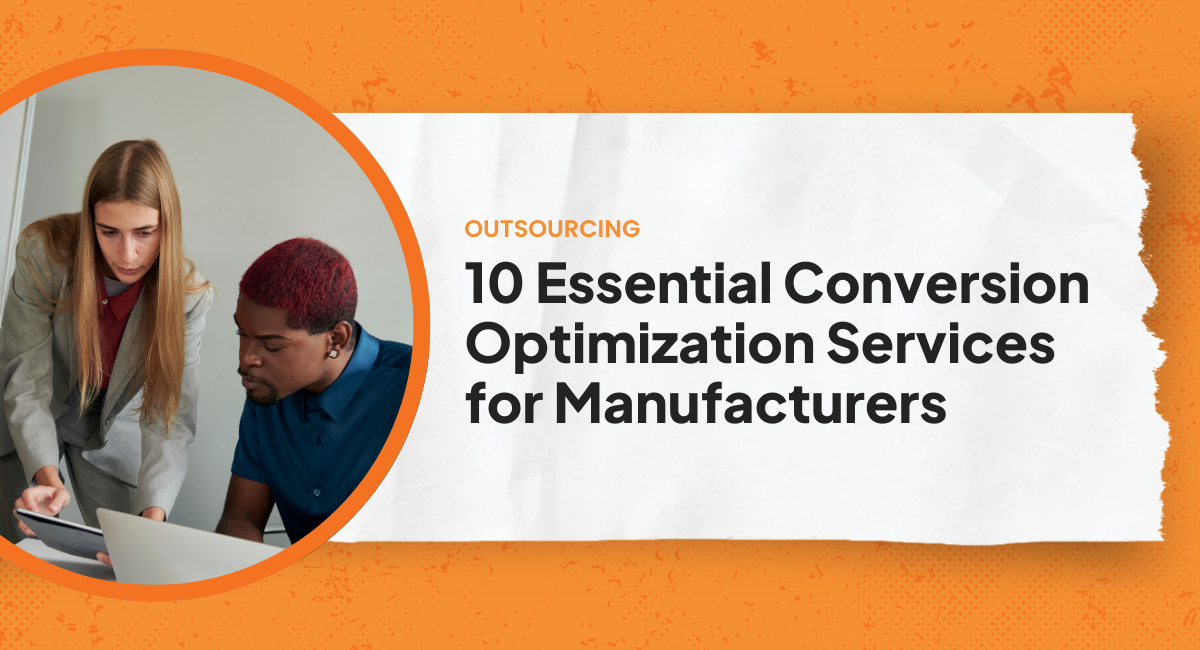
Did you know that three-quarters of the nearly 250,000 manufacturing firms in the United States have fewer than 20 employees? That’s a lot of similar competition in your industry, making it difficult to stand out to potential customers.
The manufacturing industry is focused on lead generation, finding and converting interested consumers to paying customers. It’s an organizational goal for 71 percent of manufacturing content marketers, according to one study. But for many, it is still just a goal, not a reality. Why is this, and how can your manufacturing business do things differently?
Marketing for manufacturers can be difficult. Manufacturing leads are people who know a lot about the industry and how it works, so information has to be highly specific and accurate, on top of being compelling. There is also a lot of supply in the manufacturing world, with less demand, which means your company has to be on top of lead generation to stay competitive. The more leads you can generate, and the more you can convert them into paying customers, the more clients you will have and the more revenue you will generate.
 The Dos Of Manufacturing Lead Generation
The Dos Of Manufacturing Lead Generation
Now that you have a good idea of what common errors you should watch out for and avoid, it is time to move on to what you can and should do to stay competitive in the manufacturing sector.
DO: Create a Strategy
Begin searching for leads by creating a solid manufacturing marketing strategy. Explore your different options on how to reach prospective customers. Then, figure out what types of messaging you will use for each option. Organize everything and make deadlines for each step in the process.
You need to consider and outline which channels you will use for lead generation, how you will approach each channel in terms of messaging, and how you will track your results. With a manufacturing marketing plan in place you will be organized and able to use your resources more wisely.
DO: Research Your Target Audience
Find the correct channels by extensively researching your target audience. Creating customer personas helps your marketing team drill down into what is most likely to make each lead convert into a new client. This means outlining who they are, their concerns, goals, and pain points, and what is important to them. Then, you can add in what your company offers to address all of these areas. When you market this way, your manufacturing leads will be of a higher quality, because you will be targeting real people with a real interest in your business.
DO: Create Unique Offers for Different Stages of Buying
Do you offer different levels of services or products? Be sure that you create a unique offer for clients in different stages of the buying process. Don’t miss out on any potential customers!
DO: Start a Blog
Your website should do more than just inform users who you are and what you do. Offering worthwhile blog content with strategic messaging that answers buyer’s questions increases your industry authority. It also means they’re more likely to share your content with others and doing your marketing for you.
DO: Use Search Engine Optimization (SEO)
Search engine optimization boosts organic traffic to get your better leads. However, doing it wrong can have disastrous consequences for your website. Take care that you understand before trying any SEO techniques.
A large part of manufacturing lead generation is ensuring that people can find you when they are looking for your products or services. SEO gets that done. A lot of SEO comes from researching and using the right keywords on your site, but there are many other factors to using search engine optimization for manufacturing lead generation.
For example, you could consider:
- Content marketing with a blog, which is also a great way to have your information shared across social media.
- Ensuring your business is listed in local directories including Google My Business. This is especially important in the manufacturing industry, where customers still use directories and often want to work with businesses that are geographically close.
- Investing in a new, modern web design that optimizes your site for SEO.
DO: Use Videos on Your Website
Introduce prospective customers to your existing customers and all the ways you helped them through a video. Video marketing is a proven strategy to captures attention and keep viewers interested. That’s why researchers predict all consumer traffic online will be 82% videos by 2022.
DO: Remember to Follow Up ASAP
Once someone does provide their information to your business, you need to follow up right away. If people click a call to action, you need to use that information to reach out to them and, ideally, speak in a personal way. Stick to phone calls and genuine emails rather than a form response, so you can find out what they are looking for and how your business can help. If you don’t follow up, they will find someone else who will.
DO: Assess Your Lead Generation Strategy
Periodically assess your lead generation strategy by using analytics to evaluate your failures and successes. Then, make adjustments to your strategy accordingly.
If a particular campaign or approach does not seem to be working — which you would know through using your metrics — you need to analyze what happened and where things went wrong. Often in lead generation circles, you will hear about A/B testing, which means creating two different generation methods, such as a landing page or call to action, and comparing how each worked to attract and convert manufacturing leads.
DO: Participate in Industry Events
What better way to get to know your ideal buyer than bumping elbows with them at an industry event? Even better, sign-up to give a presentation or a lecture to demonstrate your knowledge, develop trust, and provide value to potential customers.
DO: Be Patient
Manufacturing lead generation can take a few weeks or months to see results, especially if you focus on high-quality, organic leads. Be patient. When the leads do start coming in, you will see how quickly your business grows when you target the right audience.
This is especially so when focused on organic, high-quality leads. This another reason metrics are so important. They can show you upward growth faster than you might realize on your own. And, if that growth never seems to materialize, you can analyze the information available to you for concrete answers.
 The Don’ts Of Manufacturing Lead Generation
The Don’ts Of Manufacturing Lead Generation
We have worked with a lot of clients and have learned what approaches do and do not work for generating manufacturing leads and following up on those leads to convert them. If you avoid the common pitfalls outlined below, you will be in a much better position to make the most of your internet presence.
DON’T forget to use analytics to monitor your lead conversion rate
Are visitors to your business’s website only staying on for a moment before closing the page? Or, are they taking the time to look through different blog posts and service pages? Where did they come from at all?
You need this valuable information to evaluate if your lead generation plan works and, if it’s not, where and why it isn’t.
One study says 45 percent of manufacturers are not sure what percentage of leads are converted on their website, which means almost half of the industry’s businesses are operating without crucial knowledge.
DON’T settle for just any lead
What’s the point in getting someone to your website when they have no intention of following through on a purchase? A low-quality lead is not going to get you much further than no leads at all. The right kind of manufacturing lead generation should result in qualified leads, which are more likely to result in a sale or other desired action. Unqualified leads typically waste your salespeople’s time, as do working with leads that don’t have the budget for your company, can’t make buying decisions, are outside of the location you serve, and similar issues. You want to generate leads with real motivation to buy now or shortly.
DON’T: Rely on Only One Lead Generation Method
Especially when it comes to manufacturing lead generation, a one-size-fits-all approach is too simplistic for your sales funnel. Vary calls-to-action for different groups of potential customers, from those who are landing on your site for the first time and know nothing about what you do, to those who are about to decide on a sale. The more avenues and channels you explore, the bigger your pool of possible candidates.
DON’T: Forget to Leverage Your Existing Customer Base
While you search for new customers, don’t forget to leverage your existing customer base. Offer them upgrades or expansions on current products/services. Ask if they know anyone else who may need your products or services.
DON’T: Neglect Organic Leads for Paid Leads
Buying leads seems like a quick fix to find new clients. That big increase in traffic on your website at first often comes with very little return or follow-through. Focusing on organic manufacturing lead generation means you attract your ideal buyer who wants to move forward now.
The best, most qualified leads are those that come about organically. Think about it — if you cold-call or cold-mail random people from a purchased list, you have no idea if they are even interested in manufacturing. Yet, you have spent the money to buy the leads, and the time and resources to connect with them. They may even be annoyed by the cold connection and write off interest in your company completely.
You could have taken all of that and funneled it toward real leads that you can nurture. When people can opt into learning more about your business and what you do in the manufacturing world, and you can offer them some value for their time, they are far more likely to stick around.
DON’T: Focus Solely on You and Your Business
You want your business to make a good impression, but sometimes that means not focusing solely on your accomplishments. Remember that you need to address the client’s needs. Frame your strategy around answering their needs rather than showing off your skills.
You want to let people know what you can do and differentiate yourself from the competition, but keep your attention on the end-user and what your company can do for them, rather than spinning your messaging to give your business accolades (even if they are well deserved!).
DON’T: Drive Potential Customers Crazy
Keep a balance in how often you interact with potential clients. There’s a fine line between staying in their minds and becoming annoying. Pay attention to how often you’re contacting them as well as your analytics. If you notice a lot of people unsubscribing from emails or newsletters, rethink your strategy.
Even if you have followed our advice and traded paid lead generation for an organic approach, you still need to consider how your ideal prospects would react to your messaging, especially its frequency. Metrics can help you find a good frequency rate for your outreach. If, for example, you find that your unsubscribe figures are increasing, it’s a sign that your emails are too frequent or not relevant. Either way, those stats show you that you have some work to do to get back to nurturing your manufacturing leads.
DON’T: Use Too Many Calls to Action
Much like our previous point, too many calls to action can be overkill. Calls to action (CTAs) help direct prospective buyers where you want them to go through your marketing funnel. Too many CTAs clutter your pages and turn away clients. Keep things clear and easy to follow by using one or two strong CTAs, and that’s it.
One goal of manufacturing lead generation should be to keep things simple, clear, and easy to understand. Stick with one call to action that reinforces exactly what you want your prospective customer to do with the information you have provided.
DON’T: Forget to Optimize Your Website for Mobile
Since 2017, 50% of global website traffic comes from mobile devices. You don’t want to drive away new leads searching for you from their phones with a hard-to-navigate website. Optimize your website for mobile to stay relevant to users, no matter how they manage to find you.
DON’T: Forget to Reach Out for Help
If you feel overwhelmed by all these do’s and don’ts, then maybe you should think about reaching out for help.
Create an Effective Manufacturing Lead Generation Plan for High-Quality Leads
Following the do’s and don’ts listed above will help you create a great marketing strategy that earns you high-quality leads for your manufacturing business.
Not sure you have enough time or manpower to dedicate to manufacturing lead generation for your business? The professional marketing experts at David Taylor Digital understand the challenges of generating leads in the manufacturing industry. We can help you create an effective manufacturing marketing plan to attract better clients that stick around.
Get in touch with us using online messaging to let us know more about your business and how we can help. You can also call us at 973-317-8765 or email info@davidtaylordigital.com.
 The Don’ts Of Manufacturing Lead Generation
The Don’ts Of Manufacturing Lead Generation


